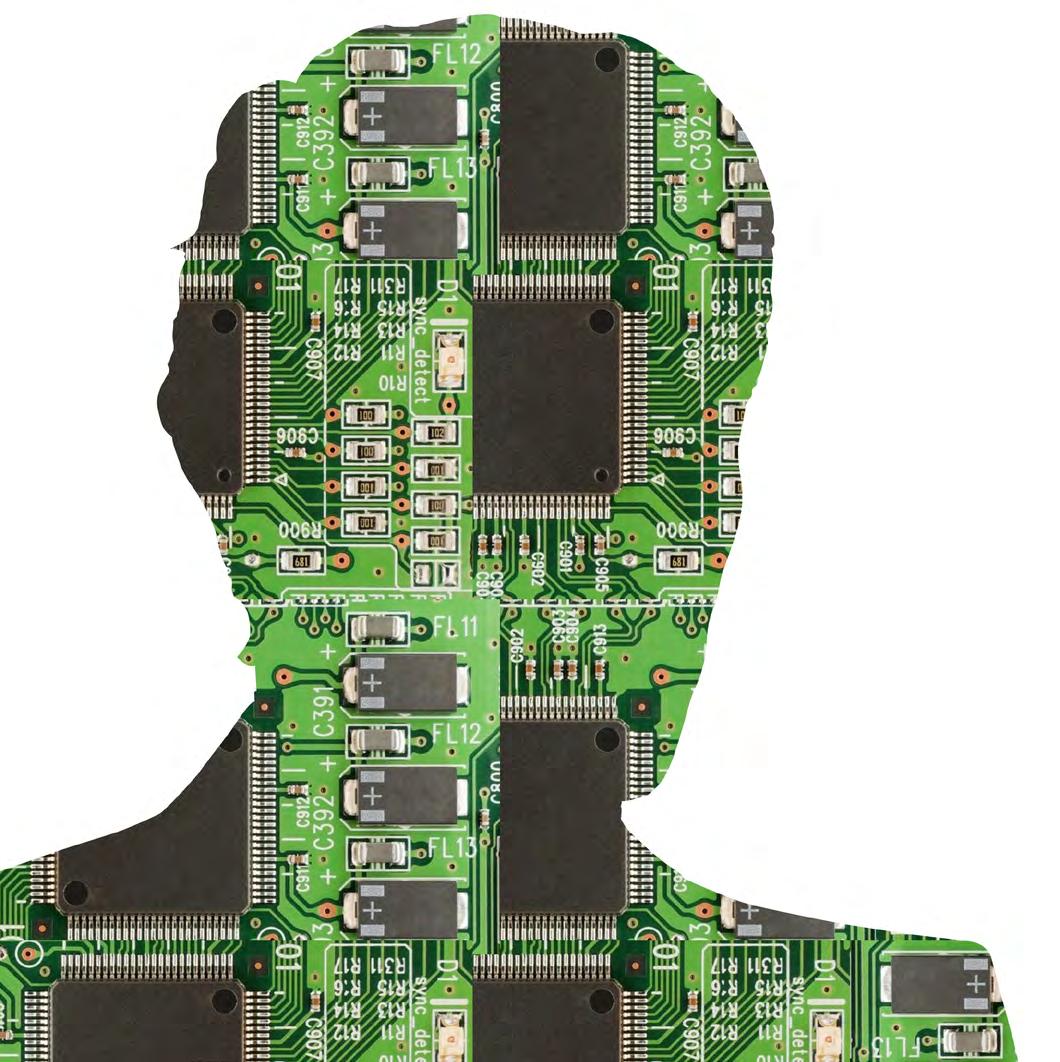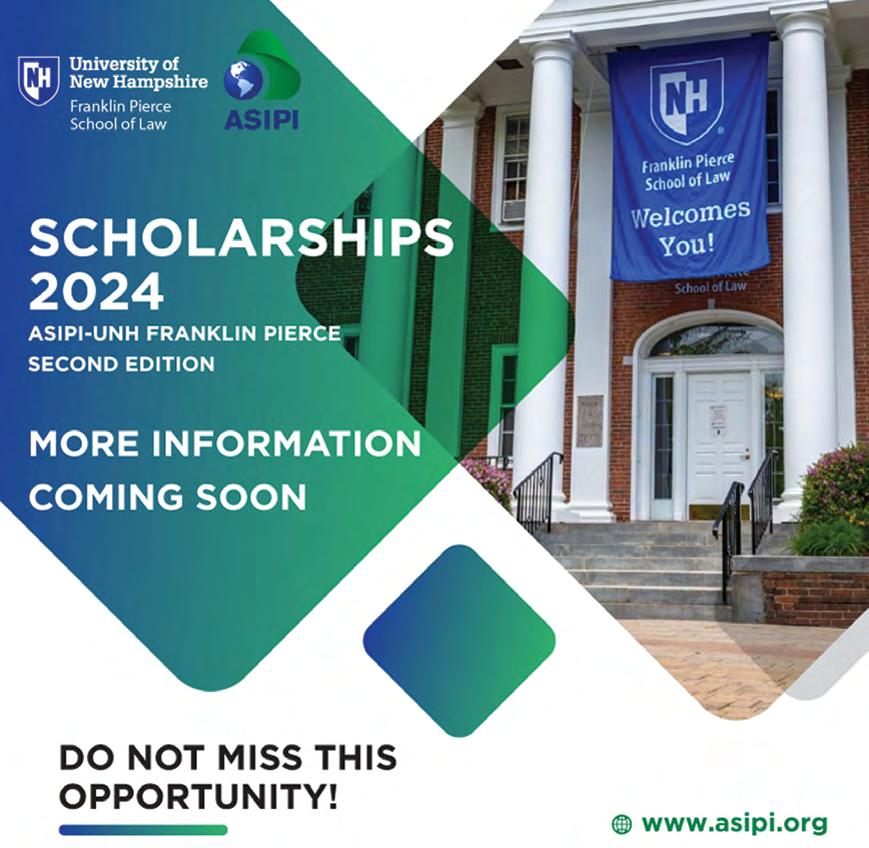
11 minute read
PROTECTION OF INTELLECTUAL PROPERTY IN A WORLD OF TECHNOLOGICAL ADVANCEMENTS AND INTELLIGENT ALGORITHMS
by MundoASIPI
The ChatGPT is a language model developed by OpenAI based on deep learning technology. It allows the computer to absorb large amounts of data from the internet and generate immediate responses to questions, write poems, perform translations, generate customized marketing strategies, design personalized games, and even generate software programs using languages like Python, JavaScript, and others. However, there are other programs with similar functionalities developed by different companies, such as T5 (Text-to-Text Transfer Transformer) developed by Google Brain, BERT (Bidirectional Encoder Representations from Transformers) developed by Google, and XLNet from Google Brain and Carnegie Mellon University, just to name a few.

And it’s not just about creating language models. There are AI tools and programs used to generate videos, presentations, and create music. We refer, for example, to Deepfake, which is a technology that uses artificial intelligence to realistically synthesize and sometimes manipulate existing videos by replacing faces and voices. We also have Adobe After Effects, widely used software in the film and animation industry for creating visual effects and generating high-quality audiovisual content. Although it is not specifically an AI tool, it can be combined with machine learning techniques to enhance workflow and improve the quality of generated visual effects.
Another case is Jukin Media, a company that utilizes artificial intelligence algorithms to automatically classify and analyze large volumes of user-generated video content, enabling them to create compilations and video presentations that can go viral on various topics. Amper Music is a platform that employs AI algorithms to automatically compose original music for videos, presentations, and other projects, adapting the style and duration based on user preferences. Magisto is an AI-based tool that allows users to create engaging video presentations from existing photos and clips.
These are just some of the AI tools available for generating texts, videos, presentations, artwork, and music. However, it is expected that in the near future, there will be many more tools as this technology is constantly evolving.

As experts in intellectual property, we recognize that all these applications are causing a significant transformation in how humanity creates, protects, and manages intangible assets. We are aware that we must thoroughly prepare ourselves to address the opportunities and challenges that this evolution brings.
For instance, there are language models capable of creating works subject to copyright protection. However, certain tests must be overcome, such as determining the ownership of the inputs or data used to train the algorithms that give rise to the AI models. Often, these data themselves are protected by copyright, raising the need to determine the extent to which the owner’s authorization is required to use such content. It may be necessary to establish exceptions that allow for the use of such content without authorization.
A second challenge relates to the protection of AI models themselves. This includes protecting the resulting software through copyright, potentially safeguarding databases through trade secrets, and, if the program can be characterized as a computer-implemented invention, seeking protection through patents.

The third challenge is related to the outputs, that is, the results derived from inputting data into an artificial intelligence model. It can be a simple decision, more data, or even a new artistic creation, which can occur when the system is fed with previous intellectual creations. This raises several questions: Can the result derived from the artificial intelligence model be qualified as a work eligible for copyright protection? Who should be considered the copyright holder of that work: the individuals behind the AI system, the AI system itself, or both? Is it a work that should be understood as belonging to the public domain?
“Zarya of the Dawn” 1 is one of the most cited cases today regarding this matter. It is a graphic novel created using the Midjourney platform by an artist named Kristina Kashtanova. This artist initially filed a copyright registration application in the United States, and the competent authority granted a copyright registration for the literary work, including its images. However, upon further investigation and determining that the images were derived from an AI system, the United States Copyright Office (USCO) canceled the initial registration and issued a new one, excluding protection for the images, considering them lacking in originality due to insufficient human involvement in the creation process. Nevertheless, this process generated several questions: Does the use of unlicensed images to train generative AI violate the law? Do AI platforms have secondary liability for infringing protected works?
To address some of these questions, in March 2023, the USCO published a document titled “Copyright Registration guidance: Works https://jolt.law.harvard.edu/digest/zarya-of-the-dawn-how-ai-is-changing-the-landscape-of-copyright-
Containing Material Generated by Artificial Intelligence,” which establishes criteria for registering works that contain material generated using these technologies.
However, the discussion does not end here, especially as we have not yet addressed the topic of patents. It is evident that with AI, it is possible to design programs trained to conduct searches and draft patents more accurately than many humans would. In fact, these programs can monitor the patent market and alert companies to potential infringements. Moreover, it appears that AI can now autonomously develop inventions, understood as the ability to make decisions, and carry them out in the external world without external influence or control.
Currently, the majority of legal systems structure patents around the concept of a natural person as the inventor. For example, U.S. law refers to an inventor as a natural person, as opposed to a legal entity. European law indirectly follows this thesis since the entire system is structured around a natural person (the forms require the name, surname, and address to designate the inventor). That is why Luz Sánchez, a Spanish professor who participated as a speaker in the panel “The Perplexity of Intellectual Property Law before the Emergence of Artificial Intelligence” at the XXII Virtual Work Sessions and Administrative Council of ASIPI in 2020, suggested the possibility of proposing to legislators the concept of electronic personality. This concept would be recognized in cases where intelligent agents generate inventions based on autonomous decisions independent of third parties.
Up to this point, we could conclude that advanced AI is a neutral technology with the potential to improve the efficiency of various processes or procedures for the benefit of humanity, while only generating some legal concerns. However, it is also true that this technology could be used to carry out harmful actions and malicious purposes. After all, AI models learn from extensive datasets, and if these datasets contain ideological biases, cultural, political, or gender stereotypes, there is a possibility that the resulting model will also reflect them.
This dual personality is observed, for example, in AI systems used for automated decision-making in areas such as public or private contracting, loans, or the justice system. While these systems can standardize and streamline processes for the benefit of stakeholders, if they are biased, they could perpetuate corruption or amplify discrimination against certain ethnicities or genders.
The same is true for content recommendation algorithms, such as those used in social media or streaming platforms, which often show users content similar to what they have interacted with before in order to generate views or traffic. This can create “filter bubbles,” where people only see information and opinions that reinforce their own perspectives, creating divisions and polarization in society.
Furthermore, advancements in AI have led to the development of techniques such as generating high-quality fake text or images that can be used for ideological purposes, spreading fake news, or manipulating elections, as seen in some countries in recent years 2
For experts like Luis Fernando Pabón, a Colombian strategy consultant at “The Cocktail,” a multinational advertising and marketing company that is part of the Wunderman Thompson group, it is crucial to ensure that AI is developed and used ethically. This entails implement -
In Forbes magazine: https://www.forbes.com.mx/manipulaciones-mediante-ia-prolifera-elecciones-estados-unidos/. Article titled ‘Manipulations through AI proliferate ahead of US Elections,’ May 30, 2023.” ing unbiased data collection practices, designing fair and transparent algorithms, and conducting regular audits and reviews to identify and mitigate ideological biases.

Pabón believes that if the accuracy and truthfulness of the data provided to the system are not regulated or controlled, humanity faces many dangers. That’s why he suggested to ASIPI Mundo to consult the open letter to the public issued by the “Future of Life Institute” in March 2023, titled “A Pause on AI Experiments.” In this letter, a call is made to all AI laboratories to suspend, at least for 6 months, the experiments they are conducting. The signatories, which include over 30,000 individuals including Steve Wozniak (Co-founder, Apple) and Yuval Noah Harari (Author and Professor, Hebrew University of Jerusalem), argue that before “advancing” further in this intelligence, we need to ask ourselves as humanity which jobs we are willing to automate and how much control we are willing to hand over to machines.

Upon reading the document, it is evident that the mentioned Institute is not against research in these matters but warns that powerful AI systems should only be deployed when we are certain that their effects will be positive and their risks manageable.
To achieve these objectives, the Institute provides specific recommendations: All actors and laboratories should collaborate in the implementation of a set of security protocols that are thoroughly supervised by external and independent experts. This will help achieve more accurate, secure, interpretable, transparent, robust, aligned, reliable, and ethical AI products. Additionally, the Institute suggests that AI developers work together with lawmakers to expedite the development of governance systems, establish a strong ecosystem of auditing and certification, and enact liability standards. The Institute also proposes the allocation of public funding for AI safety research and the creation of institutions capable of addressing the economic and political implications, especially concerning democracy, that AI could generate.
In line with this approach, the European Union (EU) has been working for several years on the development of new regulations to govern the development and use of artificial intelligence, known as the Artificial Intelligence Act (AI Act). This regulation aims to strengthen ethical standards, data quality, and transparency in the field of AI and establishes a risk classification system to assess the impact these programs may have on fundamental rights. In fact, the proposal requires that citizens be informed when interacting with an automated agent and imposes significant penalties for those who fail to comply with these rules. Although this regulation is not expected to be ready before 2024, the European Commission aims to become a global benchmark in regulating this technology, following the example of the General Data Protection Regulation (GDPR) implemented in 2015.
In conclusion, the topic we have explored in this article undoubtedly raises many debates. While we have approached it from various perspectives, it is essential to recognize that much remains to be discovered and analyzed. For example, we have not addressed surveillance practices for data collection and the risks to users’ privacy.

1. You are the Dean of the Franklin Pierce School of Law. ASIPI has had relations with that university for decades, but we recently signed a scholarship agreement with you. What does the agreement consist of?
Over the next five years, UNH Franklin Pierce will offer in excess of $1.2 million in full-tuition scholarships for ASIPI members. These scholarships include one full-tuition scholarship per year to its Hybrid JD in Intellectual Property, Technology, and Information Law; two annual full-tuition scholarships to the residential or online Masters of Law in IP (LLM), or our Masters in Intellectual Property (MIP); and three full scholarships annually to the Franklin Pierce Intellectual Property Summer Institute (IPSI). Interested candidates will respond to essay prompts provided by ASIPI

This year we received many applications and have awarded our first scholarships. We will welcome students from Peru, Brazil, Colombia, Argentina, Panama, and the Dominican Republic. We can’t wait to welcome these students to our community!
As part of the agreement, the law school and ASIPI will also initiate a series of online and in-person events for members that offer special rates for attendees of either organization. That includes an annual academic course sponsored by both parties. In addition, ASIPI will include UNH Franklin Pierce professors at its annual events.
2. How does the university and the members of ASIPI benefit from this alliance?
ASIPI is the leading regional organization dedicated to the promotion of IP across Latin America. UNH Franklin Pierce is the leading US law school dedicated to the study of intellectual property law. It is a match made in heaven!
At UNH Franklin Pierce, we value our alumni across Latin America and are thrilled to enter into this partnership with ASIPI. Our relationship exemplifies the thought-leadership of UNH Franklin Pierce and will facilitate the education of global IP leaders across Latin America and around the world for years to come, at a time when IP issues are critical for the global economy and the future of our society.
3. Why is Franklin Pierce so important in the area of IP?
Franklin Pierce provides an unparalleled education in intellectual property—we have more than 60 intellectual property courses in our curriculum, and over half of our faculty have IP expertise. Franklin Pierce also has an unparalleled network of alumni around the globe, with global heads of IP having served at places like Bayer, Disney, Samsung, WeWork, Microsoft, Lego, LG, and TSMC. Franklin Pierce alumni also lead law firms across Latin America. By attending Franklin Pierce, ASIPI members can be connected to IP leaders who will advance their careers. They will also learn about the latest developments in IP law and be prepared for future challenges.
Our program teaches students to be on the cutting edge of intellectual property issues. We have over 60 IP courses in our curriculum, more than any other school in the United States. Our approach is not just theoretical, but practical – students learn skills they can apply in practice that will help them navigate complex IP issues. We also have a faculty that takes a personalized approach. At Franklin Pierce, students make lifelong connections and friendships.
4. What can you tell us about the surroundings of the university? from Concord, New Hampshire?
UNH Franklin Pierce is in an idyllic setting in Concord, New Hampshire, walkable to downtown and next door to a park. Within an hour you can be sitting on a beach beside the ocean, hiking up (or skiing down!) a mountain, canoeing down a river, or eating dinner in one of the largest and culturally significant cities in the United States—Boston, Massachusetts. Our students who live here not only have a lifelong affection for the law school, but also for our unique community and surroundings.
5. How have Latin American students fared at that university?
Many of the intellectual property leaders across Latin America are graduates of Franklin Pierce. Whether in leading law firms like Olivares in Mexico or Dannemann Siemsen in Brazil, leading the INPI office in Argentina, or serving as trademark counsel for Lego, our graduates stand out among the crowd as IP stars, helping to carve a path for the future. Our students also develop connections that benefit them throughout their careers. One of our Latin American students told me that the con- nections he made at Franklin Pierce have helped him get jobs and clients, have helped him hire people into his firm, and have given him a global network of business opportunities and friends.
6. From your position as Dean of such a prestigious university, where do you see intellectual property going? What characteristics should an IP agent have at this time?
From data and artificial intelligence, to entrepreneurship and innovation, to health care, finance, and climate change, intellectual property is at the center of many of the grand challenges we face as a global society. Having a global perspective on issues in IP can help us turn those challenges into opportunities.
A global approach to IP is valuable, and will be more and more important in the coming years. As the legal framework surrounding human creativity, intellectual property is relevant across industries, and provides the foundation for innovation and invention. Transactions in IP are the system of movement for innovation around the world. It is my belief that an education in intellectual property will be valuable no matter what industry or specialization one is in, that as technology develops, intellectual property is the foundational education of the future.
We are particularly grateful to the leadership of ASIPI for sharing our commitment to educating the IP leaders of tomorrow, including Enrique Diaz, Luis Henríquez, Jorge Chávarro, Matias Noetinger, Martin Pittaluga, Giselle Reuben and Juli Gutiérrez. The executive committee and the entire administrative team have always been attentive to all the details of this agreement to ensure its success. We are happy to work with ASIPI










